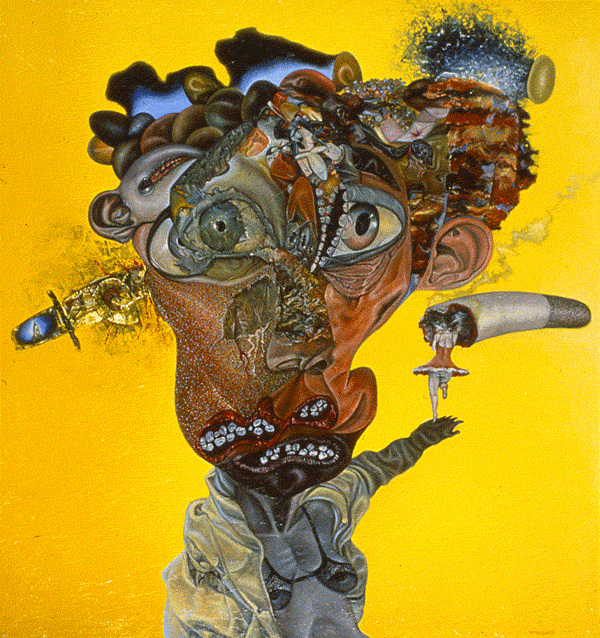
I experienced Terence McKenna’s “Machine Elves” as a young boy, not as a result of consuming a hallucinogen but as part of a brain fever I had only a 50-50 chance of surviving. I would not liken these entities to woodland creatures or unicorns, but rather to the folk horror “fairy folk” of Welsh writer Arthur Machen.
It is possible that these entities, because of their harsh stares, and rapid tooling apsect of their hands, gave physical dimension to the operating system of autism. I felt like I was intruding on their work, and they were none to happen to see me. Such perturbation is a common reaction where the autistic does not like being interrupted or watched while doing their “thing.” This theory does not explain machine elves entirely, since any entity encountered in a dream state may mask a deeper metaphysical reality.
Appertaining to the fever, I experienced not only visions of anthropomorphic creatures busily working, as over machinery or a beehive, but I also experienced Alice in Wonderland Syndrome, or dysmetropsia, while perceiving them. This condition results in distortions of perception: i.e., objects being closer, further away, larger, or smaller than they really are. In my situation, I experienced all four incongruous states simultaneously. My monsters did not exist in any rational space, which may also explain why, in my early paintings of monsters, I paid little heed to the rules of spatial depiction—or, at least, I did not regard these rules as important to what I was trying to accomplish.
For years after my childhood illness, I continued to experience a milder form dysmetropsia, though fleetingly and only when I lay down to nap or sleep. Ed Big Daddy Roth’s hot rod monster bubblegum cards and 1950s monster movies were more material influences on my monster mania of the 1960s. I have since domesticated my monsters to fit into functional landscapes with less discord.
Hover to find linked images.

Near the end of my education at IU, a fellow student introduced me to the works of Giuseppe Arcimboldo, the Sixteenth Century Italian/German painter best known for portraying his human sitters as composites of various plant and animal matter. In discovering him, I was given both a precedent and a template for the type of painting I wanted to pursue.
The Death Rattle of Tchaikovsky was the last painting made for the Chicago show in 1990, and it marked the beginning of my wilderness years. Somewhere around its creation, I switched from a calcium carbonate ground to a lead ground, which was the preferred method at IU. There are advantages and disadvantages to this method. Because logistics did not allow it later on, I returned to purchasing acrylic gesso-primed canvases around 2010, with only minimal pretreatment of the surface to suit my needs.
Post-Chicago Slump: The paintings I created on canvas between 1990 and 1997 number no more than those listed on this page: five. Several acrylic works on paper were also created as cover and splash pieces for comic book projects in this decade, although the best ones came late, including for my Xeric Foundation Grant comic book. These mixed media works on paper may be seen among my comic portfolio pages.
I cannot supply a complete list of color work pre-1998 other than to say that I attempted color infrequently. “Attempted” is a fair description since my “paintings” at this stage were, in a sense, orphaned in not having a clear end use. This being said, the 1990s is the decade in which I came into my own as an artist—not through painting but through drawing comics. This know-how was transplanted to painting by decade’s end.
Fudging Dates: There are few questionable practices to which a painter should confess, but in discovering that Giorgio de Chico postdated many of his later paintings to reflect an earlier period of his career, for the sake of raising their value, I did something like this in the mid-90s, only in the opposite direction, time wise.
As I discuss at the end of this page, I exhibited three canvases at a gallery in New York City in 1997. And because I created so few oil paintings in this decade, I fudged the completion dates to put them closer in time to the exhibition, believing New York collectors would not be interested in buying older canvases from a “new emerging artist.” Later I stopped dating my canvases to avoid the perception that I am lackadaisical about pursuing painting seriously. However, course corrections and detours are the common lot of artists.
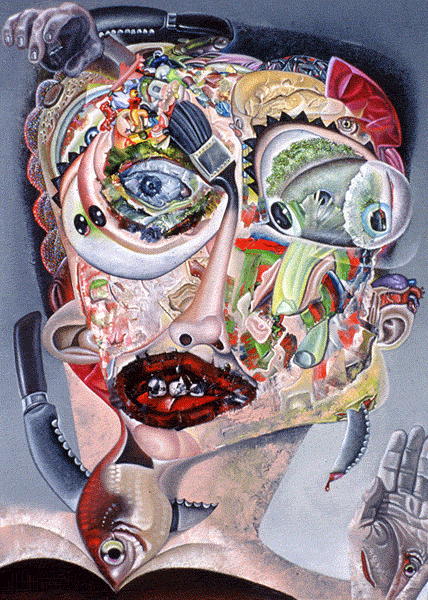
I ended up destroying this canvas, probably because I tried to carve out negative space in it and failed. Perhaps out of regret (or guilt), I later repainted the red fish pictured here in Le Voiture d ’un Buffoon Flambé. It is seen in the second detail for that painting.
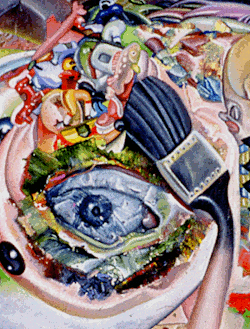
Steak Knife Facial (detail). I do not have high quality slides from this time. This period predates the purchase of my first digital camera. Nevertheless, this detail gives outline to the type of surfaces I was pursuing from the mid-80s through the mid-90s:
While the central eye was still wet, I went in with a palette knife and sliced through its contours, similar to what I did in The Death Rattle of Tchaikovsky. I then used a detail brush to pull out a topographical relief from the marks. A nebula of green hatches was added around the eye with a palette knife. The paintbrush growing out of the bridge of the nose reinforced the idea that everything above the eye, including a dense field of small toys, was more whirling painted elements.
I did not view Steak Knife Facial or Cowboy Still-Life as successful paintings. As I expressed on the previous page, I experienced a mild but protracted depression following the loss of graduate school, so taking up a paintbrush to paint monsters in the middle of rural Indiana seemed somewhat pointless. Comics, however, did not require me living in a large city, so I found more happiness in these pursuits, although, here again, I was still a square peg sizing up round holes.
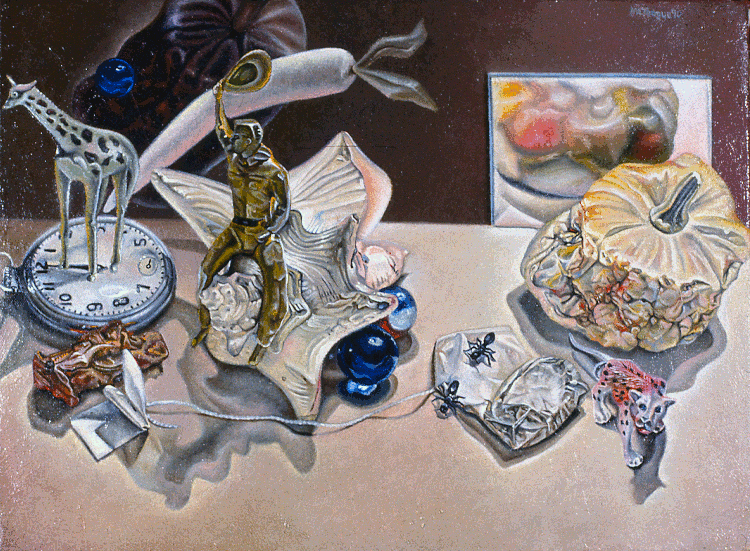
This small still-life is static when compared to the wood panel paintings of similar size from the previous page. However, this work has a hyper-realist treatment of its key elements, with no abstract flourishes being added. This war between realism and abstraction in my art would not be resolved for a number of years. Cowboy Still-Life was later cannibalized for the Epic Dermis painting below.
My palette, post-Chicago show, was subdued and favored browns and earth tones. The bright cadmium red background for Epic Dermis (below) was neccessary given the low key color throughout the canvas.
The dates for Epic Dermis, so marked on its reverse side, show a timeline stretching from 1996 to 1997, but, as I described above, this is too late. By its technical execution, and by the aforementioned act of cannibalism, it was first among my large monsters paintings. I may have started it as early as 1990 or 1991. Epic Dermis also became the title for all my book-form comics after 1992.
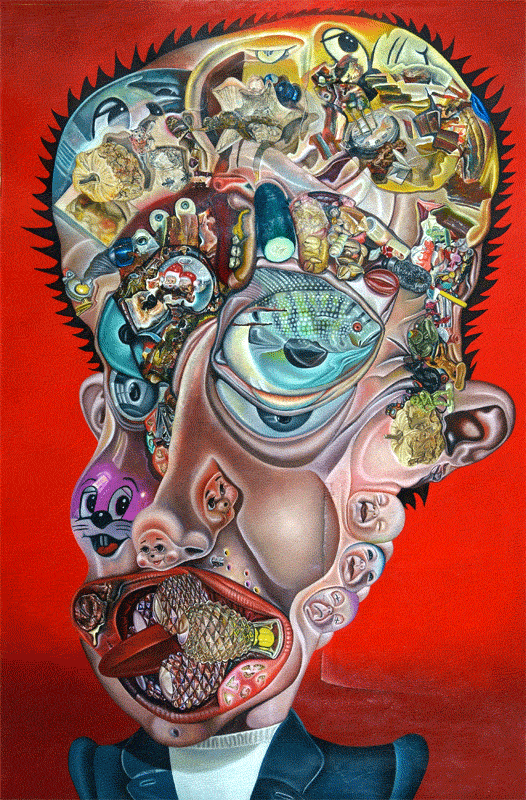
My use of collage elements in this painting may be chalked up to resourcefulness in not wanting to throw away the best bits of destroyed paintings. Regardless, collage, whether genuine or facsimile, is not stylistically unusual for me. The upper potion of Epic Dermis resembles a collection of self-organizing islands. Each contains groupings of minor still-life objects (painted from observation) and monster vignettes (painted from imagination).
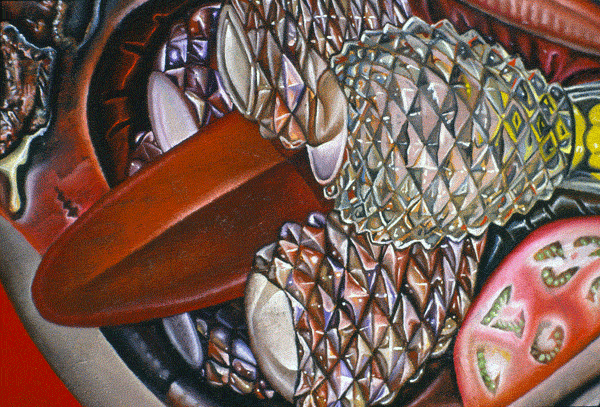
These glass containers were painted early on, and it may have been some time before I returned to this canvas with any sort of energy. During the course of this painting, I floated in and out of its spell over several indecisive years while I redoubled my effort in drawing and writing comics.
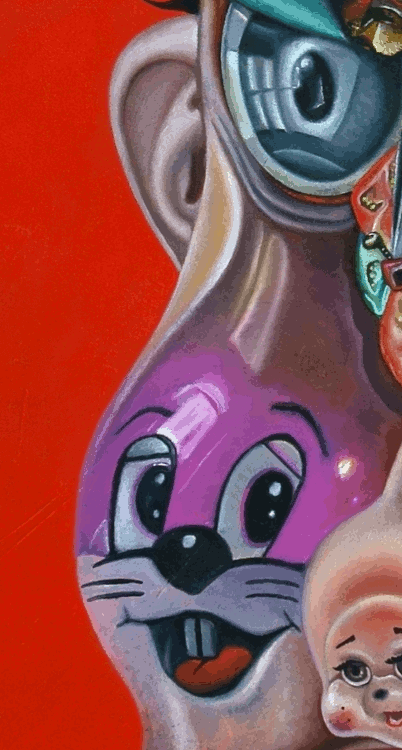
These inflatable bunnies were popular in the early 1990s. I bought one in each color: pink, blue, and yellow. The yellow one was used for the cover of Dreams of Bad Milk, which may be seen in my comic portfolio pages.
Collage and Max Ernst: The Surrealist Max Ernst is an influence on my work at this time. Collage was one of his methods, but more so his general idea of excavating from random brushstrokes, spills, etc. This exploration, removed from any central plan imagined for the composition as a whole (and I worked from no central plan in this period in my painting), made my finished canvases resemble topographical reliefs, pareidolia, and bathroom stall doodles. Unintentionally, they looked like collage, and so easily married to true collage. This stitched-together, part-to-part process compares to the imaginary maps I made as a child.
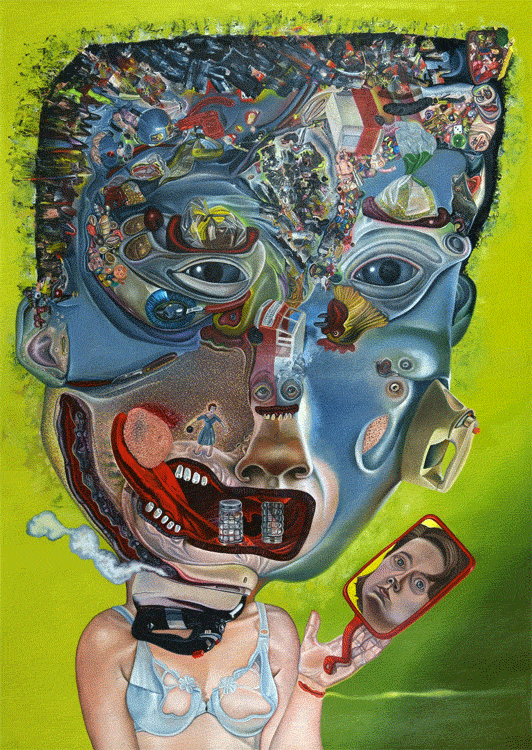
This second monster painting is significantly larger than either of its cousins.
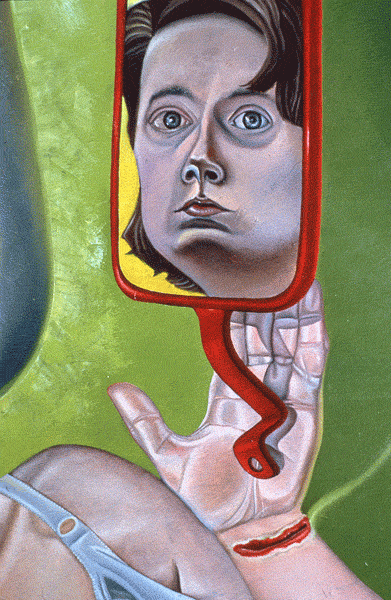
This is a self-portrait. The slit wrist reflects my sullen mood throughout this decade of failed expectation. However, my thoughts were never truly suicidal, only self-pitying. Given how few paintings I created during this period, each canvas was like a cave wall upon which I journaled about my interior life—at least until I ran out of room and needed to start a new painting.
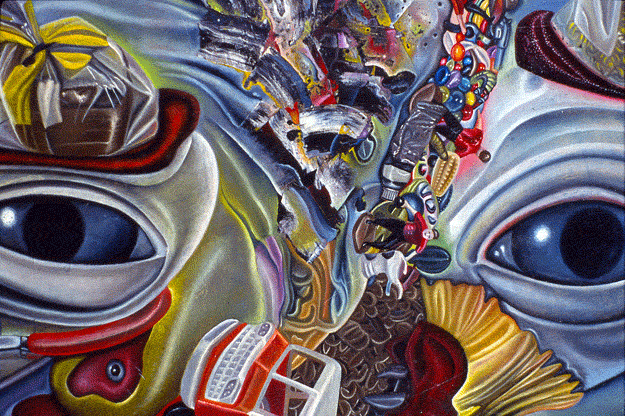
With each monster, details became less collage-like (realism cut-and-pasted onto a flat surface), and more embedded into three-dimensional depictions of skin.
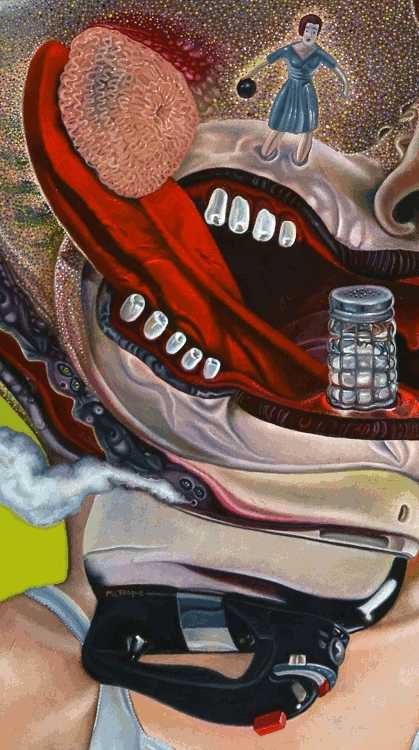
This detail shows a repainted tongue. This operation was carried out over the summer of 2021.
The plastic pan scrubber is nearly identical to what was seen in Halloween Pangs II from the previous page. I recycled ideas across this decade of painting, similar to how I recycled drawings and gags in my comic book work.
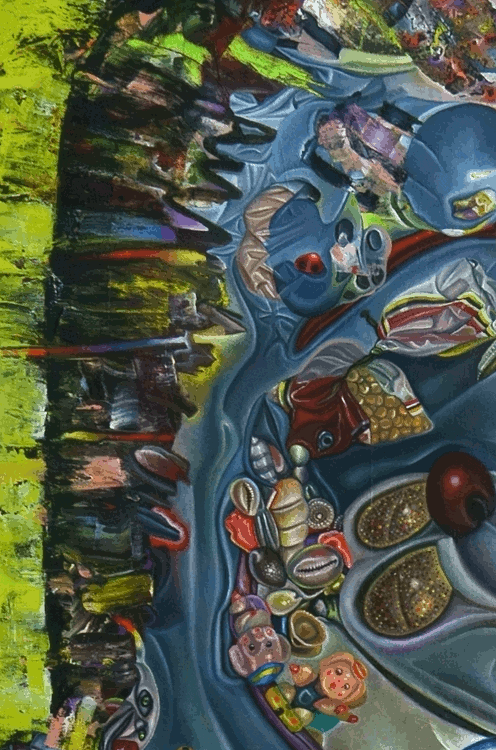
As with Steak Knife Facial, I was mashing together palette knife work with cartoony realism. As with the previous detail, the small popcorn bag fashioned to resemble an inverted angel fish is the same popcorn bag seen previously in Popcorn Placenta. This is one of two popcorn bags depicted in Earwig.
Cartoon Realism: It is difficult to anticipate how light and shadow will fall across a teeming surface. Moreover, it was not clear to me, given my assemblage approach, how realistic depictions of light would enhance my finished product.
The development of 3-D computer modeling was still in its infancy at this time. Complicated lighting effects were now possible through software; but because figures could be made to look impactfully realistic in this way, every artist with a computer gravitated to the technology. Computer animation, in much the same way airbrush illustration became in the 1980s, looked off-the-shelf. This great stylistic leveler effect is undesirable since one person’s 3-D modeling looks much like another’s. It is the old joke of “throw a Photoshop filter over it.”
Analog imagination is required to envision whimsical monsters. Digital monsters may possess impressive layers of spit, polish, and realism, but their three-dimensional functionality limits the directions in how they may evolve. The latent spaces arising from current artificial intelligence art generators—that is, in how A. I. fumbles around in dark rooms to get from one place to another—is closer to what I do in practice than any intended product of this process.
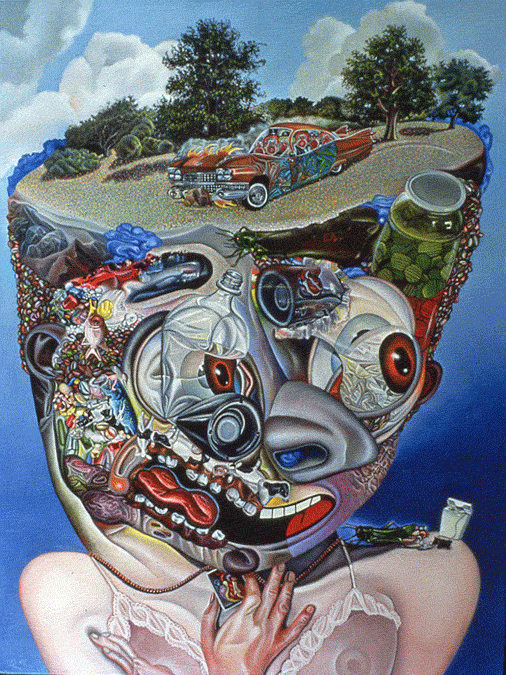
This is the third and most “realistic” of the three monsters. However, it is still a mixture of flat and spatial components. The mouth, for example, is flat and cartoonish, while the top of the head is a conventional landscape.
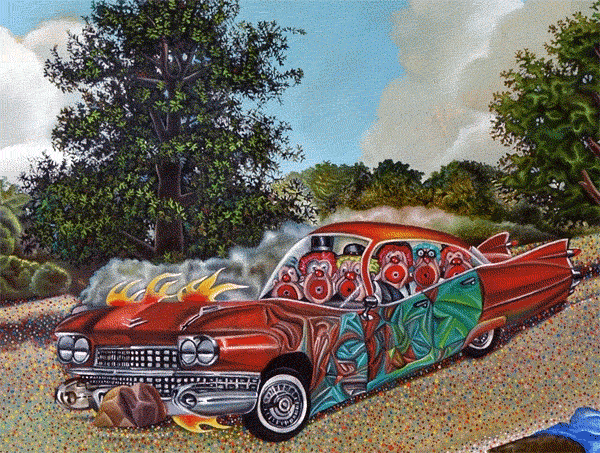
Because the official completion date for Voiture was 1997, this puts it within spitting distance of Brussel Sprout Cheesecake and other works seen on the first Gallery page. In terms of style and technique, Le Voiture has more in common with these paintings than it does with Epic Dermis. At the time, however, I was anxious to remove all three monsters from their stretchers and store them out of sight. I was ready to move on.
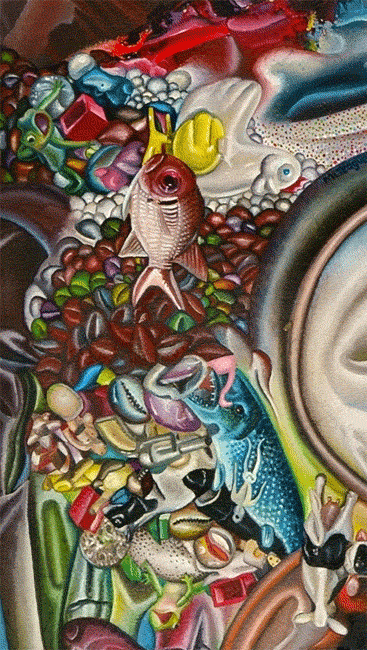

Penises, and bodily organs that might be confused for penises, are found here and there in my paintings and drawings of this period. This is me tagging my artwork with a type of graffiti, as one might deface a wall in a dilapidated building. Since these canvases leaned against a wall in my apartment for much of their time residing on stretchers, they resembled abandoned walls upon which I occasionally directed a paintbrush.
A Final Note: In September, 1997, I exhibited these three monster paintings at The Slowinski Gallery in New York City at great expense. I did not attend the opening, and no sales were forthcoming. I vowed never again to paint so large that my paintings required handmade wooden crates for shipping.
It did not occur to me, until recently, that the size of these three paintings contributed to my disenchantment with painting throughout the mid-90s. By committing to this scheme of scale, I had made a deal with the devil. Some part of me understood that these colossal projects were sucking the fight out of me. I persevered and finished them, but at the cost of not painting anything else on canvas during their ordeal.
Art?Alternative Magazine: I cannot say how I came to purchase a copy of Art?Alternative Magazine, or where I bought it. It featured the work of cartoon surrealist painter Todd Schorr, and I pored eagerly over its pages. Juxtapoz Magazine may have existed before this magazine, but I did not discover it or the California Lowbrow Art Movement until later. Not only did Art?Alternative Magazine inspire me to paint again, but it made me hopeful about a future for art where the approval and real estate of Manhattan galleries were no longer required.
I sent slides of my work to Art?Alternative, but the magazine was defunct by then. The publication reemerged briefly and featured my work in an issue, although the image quality was less than ideal.
The Great Filter: In every creative venture I have undertaken in my life, I have met with a “great filter” of some sort. Ususally the filter is bad timing or, in the instance I just described, bad reproductions of my artwork in a magazine. Sometimes it is just my own stupidity or stubbornness.
For the next chapter in my painting story, we skip ahead to the Lowbrow, Pop-Surrealist movement, and my loose association therewith. I would like to think that I was in the vanguard of all that.
Copyright © 2016 michael l. teague all rights reserved.